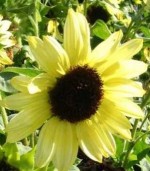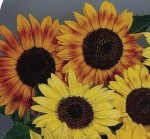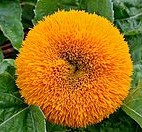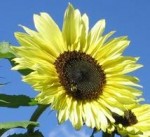
Here are some points to consider when choosing sunflowers.
Height of Plant:
Sunflowers can be divided into three basic size classes:
 Tall: At 10’ or more they are good back of the border plants but usually need staking.
Tall: At 10’ or more they are good back of the border plants but usually need staking.Examples:
-
‘Kong’ Hybrid (12’ tall with 4-6” wide yellow flowers)
‘Giganteus’ (10-12’ tall with 8-10” wide yellow flowers)

 Intermediate: Under 10′ but taller than 3′, these plants are more compact, have smaller flowers and are not as coarse looking.
Intermediate: Under 10′ but taller than 3′, these plants are more compact, have smaller flowers and are not as coarse looking.
Examples:
- ‘Valentine’ (to 5’ tall, 6” wide lemon yellow flowers)
‘Holiday’ (2-6’ tall, 4” wide yellow flowers)


 Short (Under 3′ tall, these sunflowers are more easily used in the garden border; the smallest varieties may be successfully grown in containers.
Short (Under 3′ tall, these sunflowers are more easily used in the garden border; the smallest varieties may be successfully grown in containers.
Examples:
-
‘Moonshadow’ (1’ tall. 4” across pale yellow flowers)
‘Music Box’ (2-3’ tall, 4-6” across yellow-mahognay flowers borne abundantly)
Flower Size:
You many have noticed that in general, large plants have large flowers and smaller plants have smaller but that is not always the case. ‘Sunspot’ is only 2-3’ tall but has flowers that are 10” across! Wild sunflowers are small but most sunflowers grown in the garden measure about 4-6” across.
Number of Flowers Per Plant
Some varieties of sunflower produce only one or just a few flowers but others like ‘Velvet Queen’ are branched and produce many flowers over a period of time.

The typical flowers of sunflowers are actually made up 1,000-2,000 flowers growing tightly together in a compact head. The center is composed of disc flowers that may become seeds after pollination; the outer, ray flowers, are sterile, showy, and can be shades of yellow, orange, and red. A variation of this occurs in double forms like such as ‘Teddy Bear’ (2-3’ tall, 6” wide yellow double flowers). The flowers look fuzzy.

Flower Color
Yellow ray flowers seem to be the most common color but as you may have notice from the pictures above a beautiful array of oranges, bronze, and reds are also possible. Creamy white is also a option. ‘Moulin Rouge’ hybrid (5-6’ tall) bears 5-10” wide velvety maroon flowers), ‘Soraya’ (5-6’ tall) has 4-6” wide orange blooms, and ‘Ring of Fire’ (4-5’ tall) is a bicolor with 5” wide burgundy and yellow flowers. ‘Italian White’ (5-7’ tall) has 4” creamy white blossoms.
Not all disc flowers are brown. ‘Sunrich Gold’ (4-5’ tall) has 4-5” wide flowers with a bright green center.

Use
The sunflower was originally grown for oil (try ‘Progress’ if that is your ilk) but the majority of the seeds available are for garden use. Handsome as sunflowers are in the garden, however, you might want to consider growing them for their seeds. ‘Large Grey Stripe’ ( 8-12’ tall) produces flowers that are 20” wide filled with large, thin-shelled, seeds that make a delicious snack for birds or humans. If cut flowers are a goal, consider the varieties that have long stems like like ‘Sunrich Orange’ (4-5’ tall, 4-6” wide orange flowers) and is pollenless, a plus for indoor arrangements. If an instant bouquet might be more to your liking, try ‘Moonwalker’ (6-10’ tall, 6” wide light yellow flowers) with its branching habit.
Sunflowers are easy to grow. They germinate readily, require only a couple of applications of fertilizer, and have few disease or pest problems. They do need a good amount of water but can tolerate an occasional mild lack. There are so many different sunflowers available, every gardener should find one to suit her garden. And sunflowers are a great way to introduce children to the wonders of gardening.